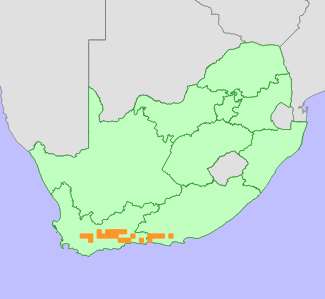|
Scientific Name | Leucadendron comosum (Thunb.) R.Br. subsp. comosum |
Higher Classification | Dicotyledons |
Family | PROTEACEAE |
Synonyms | Leucadendron aemulum R.Br., Leucadendron deasii E.Phillips |
Common Names | Common Ridge-cone Conebush (e) |
National Status |
Status and Criteria | Least Concern |
Assessment Date | 2020/03/06 |
Assessor(s) | A.G. Rebelo, H. Mtshali & L. von Staden |
Justification | Leucadendron comosum subsp. comosum has a wide distribution range with an extent of occurrence (EOO) of 21 422 km². It is common with many subpopulations occurring as dense stands. There are no current severe threats to this species, but it is potentially vulnerable to competition from alien invasive plants and inappropriate fire management. However, these threats are unlikely to rapidly cause this species to become threatened within a short time frame. These threats may increase this species' risk of extinction in the longer term, and needs to be managed and avoided. |
Distribution |
Endemism | South African endemic |
Provincial distribution | Eastern Cape, Western Cape |
Range | This subspecies is endemic to Western Cape mountains in South Africa, where it occurs in Swartberg, Langeberg, Outeniqua and Kouga mountains, with isolated populations on the Touwsberg and Rooiberg in the Little Karoo. |
Habitat and Ecology |
Major system | Terrestrial |
Major habitats | Kouga Grassy Sandstone Fynbos, Kouga Sandstone Fynbos, South Kammanassie Sandstone Fynbos, North Kammanassie Sandstone Fynbos, South Swartberg Sandstone Fynbos, North Swartberg Sandstone Fynbos, South Rooiberg Sandstone Fynbos, North Rooiberg Sandstone Fynbos, Tsitsikamma Sandstone Fynbos, South Outeniqua Sandstone Fynbos, North Outeniqua Sandstone Fynbos, North Langeberg Sandstone Fynbos |
Description | It occurs in montane sandstone fynbos, 800-1800 m. Mature individuals are killed by fires, and only seeds survive. Wind-dispersed seeds are stored in fire-resistant inflorescences, and released after fires. It is dioecious, with insect-pollinated male and female flowers occurring on separate plants. |
Threats |
| A very small proportion (6%) of this subspecies' habitat has been lost in the past. However as most of the remaining habitat is protected, this threat has ceased. Currently, there are no severe threats to this species, but it is potentially threatened by competition from alien invasive pine seedlings, spreading from nearby plantations and too frequent fires.
As a reseeder, L. comosum subsp. comosum is potentially vulnerable to too frequent fires, as local extinctions can occur when fires repeatedly kill individuals before they reach reproductive maturity. |
Population |
This subspecies occur in dense stands. The largest subpopulation occurs at Touwsberg with over 200 000 plants. The population trend is stable, but it is likely to decline if alien invasive plants are not managed.
|
Population trend | Stable |
Assessment History |
Taxon assessed |
Status and Criteria |
Citation/Red List version | | Leucadendron comosum (Thunb.) R.Br. subsp. comosum | Least Concern | Raimondo et al. (2009) | |
Bibliography |
Raimondo, D., von Staden, L., Foden, W., Victor, J.E., Helme, N.A., Turner, R.C., Kamundi, D.A. and Manyama, P.A. 2009. Red List of South African Plants. Strelitzia 25. South African National Biodiversity Institute, Pretoria.
Rebelo, T. 2001. Sasol Proteas: A field guide to the proteas of southern Africa. (2nd ed.). Fernwood Press, Vlaeberg, Cape Town.
|
Citation |
| Rebelo, A.G., Mtshali, H. & von Staden, L. 2020. Leucadendron comosum (Thunb.) R.Br. subsp. comosum. National Assessment: Red List of South African Plants version 2024.1. Accessed on 2025/12/23 |
 Comment on this assessment
Comment on this assessment

